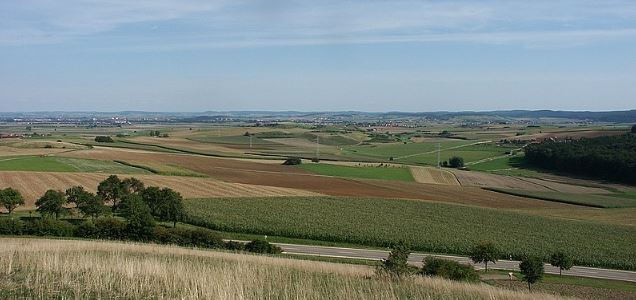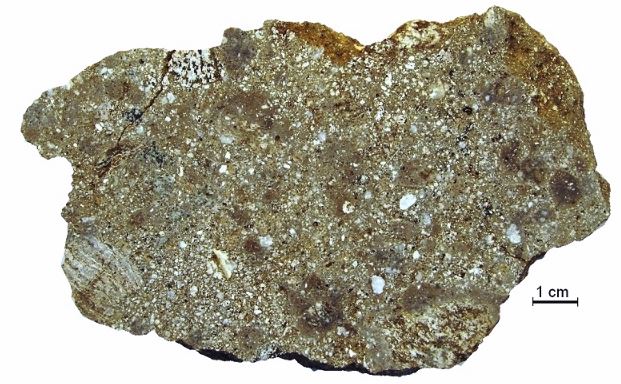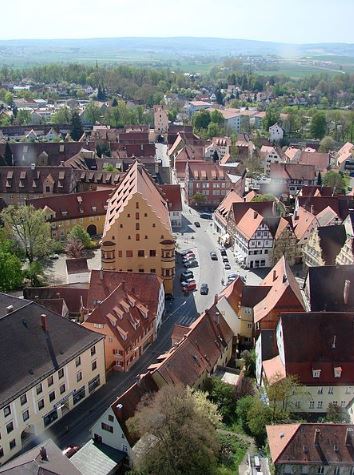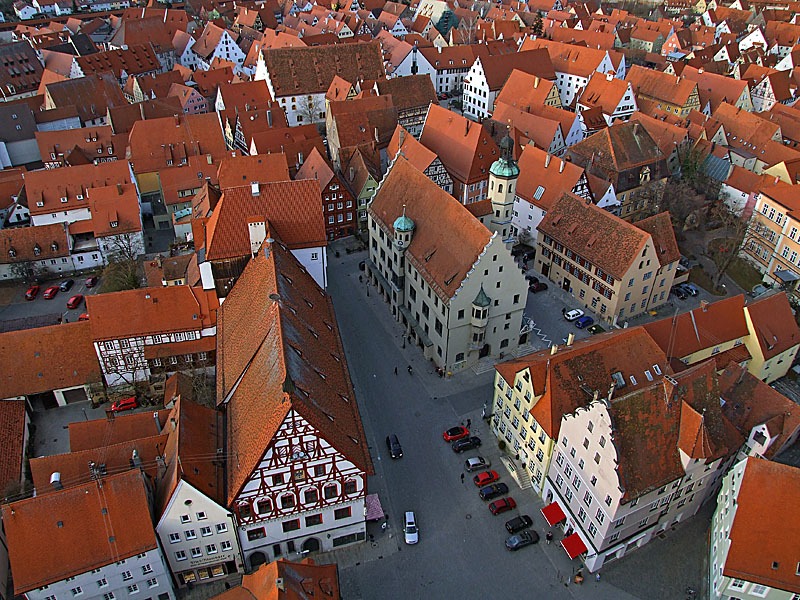The Nordlinger Ries is an impact crater located north of Danube in the Donau-Ries district. It is a significant circular depression in western Bavaria and eastern Baden-Wurttemberg. The depression of the impact crater has a town in it about 3.7 miles (6 km) southwest of the crater center. The full impact crater can only be seen from the air. However, the inner ring is highlighted by the city walls. The reason you cannot see an immediately visible Nordlinger Crater is due to erosion.
Nordlinger Crater was created 15 million years ago. According to NASA’s Earth Observatory, the existence of the crater likely eluded medieval Europeans who unknowingly bound their city walls to the inner ring of the crater about 0.6 miles (1 km) in diameter. A meteorite hit the earth’s surface at a speed of 43,000 mph (70,000 km/h) which is now a state of Germany.
Formation of Nordlinger Crater
According to ESA, the meteorite was traveling at over 43,000 mph (70,000 km/h) when it hit the Earth’s surface. As a result, it exposed the surrounding rock to phenomenal pressure and created a heat of more than 45,000 degrees Fahrenheit (25,000 degrees Celsius). The extreme conditions created microscopic diamonds.
The depression is a meteorite impact crater formed 15 million years ago during the Miocene period. The impact crater is usually referred to as Ries or Ries Crater. However, the original rim of the crater had an estimated diameter of 16 miles (26 km).
The Nordlinger Crater has been a victim of erosion like other craters on earth such as the Wolfe Creek Crater. The current floor of the crater lies 100 to 150 m (330 to 490 feet) below the eroded remnants of the rim.
Scientific Significance of Nordlinger Crater
The Ries was initially assumed to be a volcanic crater. Nordlinger Ries has been a debate like other craters on earth such as Lonar Crater if it is a volcanic or impact crater. In 1960, Edward C.T. Chao and Eugene Shoemaker showed that the crater was formed by a comet from our solar system hitting the earth’s surface. The main evidence was the presence of coesite which in unmetamorphosed rocks can only be formed by shock pressure.
Coesite was found in Suevite from the Otting quarry but even earlier Shoemaker was encouraged by Nordlingen St. George’s Church built by locally sourced Suevite. Suevite was formed from Mesozoic sediments shaken by the meteor impact.
The Ries impact crater was a rampart crater due to its uniqueness on Earth. Rampart craters have been found mostly on Mars. The rampart craters exhibit a fluidized flow of ejecta after a meteor impact. For example, when a bullet is fired through mud, the ejecta resembles a mudslide.
Steinheim Crater
Another impact crater with a smaller diameter of 2.36 miles (3.8 km) is located 26 miles (42 km) west-southwest of the center of the Nordlinger Ries. Just like other craters on earth such as Kaali Crater Field, this impact crater lies within the main crater. It is known as Steinheim Crater.
Both craters were thought to have been formed simultaneously by a binary asteroid impact 15 million years ago. However, a study published in 2020 suggests that Steinheim was 500,000 years younger than Nordlinger Ries. Recent computer modeling of the impact event indicated that the impactors were likely to have a diameter of approximately 0.93 miles (1.5 km) (Ries) and 150 m (490 feet) (Steinheim).
The meteorite had a separation before the impact of a few tens of kilometers. A comet from our solar system hit the earth’s surface at an angle of approximately 30 to 50 degrees in a west-southwest to east-northeast direction. The velocity of the meteorite is thought to have been 20 km/s (72,000 km/h; 45,000 mph). When the meteorite hit the surface, it created an explosion with the power of 1.8 million Hiroshima bombs with 2.4 x 1021 joules of energy.
It is believed that Nordlinger Ries Crater is a source of the moldavite tektites found in Moravia and Bohemia. The tektite melt came from a sand-rich surface that was ejected up to 280 miles (480 km) below the crater. The shape of the seeded field suggests that the direction of the impact was from the west-southwest.
The stone buildings of Nordlingen contain millions of tiny diamonds. All the tiny diamonds have a diameter of 0.2 mm (0.008 inches). The Nordlinger Ries impact created about 72,000 tons (72,000,000 kg) of tiny diamonds when it impacted a local graphite deposit. The stone from this area was extracted and used to construct the local buildings.
Astronaut Training In Nordlinger Ries
The Apollo 14 landing site is heavily cratered terrain, and one of the mission’s scientific objectives was to sample material ejected from the impact that formed Mare Imbrium. Nordlinger Ries is a large and easily accessible impact crater like other craters on earth such as Barringer Crater making a handy analog for lunar craters. For this reason, it was used as a training ground for Apollo 14 astronauts so they could study lunar impact structures and associated rocks.
Astronauts Edgar Mitchell and Alan Shepard along with Apollo 14 backup astronauts Joe Engle and Eugene Cernan trained from August 10 to August 14, 1970.
Nordlingen Town in Nordlinger Ries
Nordlingen is a town in the district of Donau-Ries in Swabia, Bavaria, Germany, with a population of approximately 20,674. It is located approximately 17 miles (115 km) east of Stuttgart and 90 miles (145 km) northwest of Munich. It was built in a 15-million-year-old and 16 miles (26 km) diameter Nordlinger Ries.
In 898, Nordlingen was first mentioned in recorded history. The town was the site of two battles during the Thirty Years’ War, which took place from 1618 to 1648. Today it is one of the three towns to have intact city walls in Germany. The other towns are Dinkelsbühl and Rothenburg ob der Tauber.
Another attraction in town is the 300-foot (90 meters) steeple of St. George’s Church, called Daniel. It is made of Suevite impact breccia containing impacted quartz. Other notable buildings include the Town Hall dating back from the 13th century. Furthermore, there is the Church of St. Salvator and the Spital, a former medieval hospital
The Ries Crater Museum is located in the well-preserved medieval tanners’ quarter. The city is home to several other museums such as the Bavarian Railway Museum, the Augenblick Museum, the Nordlingen City Museum (Stadt museum), and City Wall Museum (Stadtmauermuseum).
The latter offers panoramas, silent films, magic lanterns, mechanical pianos, barrel organs, gramophones, and music boxes. Nordlingen is known for the Scharlachrennen (Scarlet Race), a horse racing tournament first mentioned in 1463. Since World War II it has expanded to include events, dressage, jumping, and horse racing.
Nordlinger Ries In Pop Culture
- The American film Willy Wonka and the Chocolate Factory (1971) shows a view of Nordlingen in the final aerial scenes.
- Fans of the manga and anime series Attack on Titan have come to believe that the layout of one of Shiganshina District’s main sites was based on this town.
This belief started as a theory from the dawn of the internet but was popularized when the variety show Sekai Fushigi hakken uncovered the mysteries of the world and visited Nordlingen during a November 2013 segment on southern Germany. The segment actress made Attack on Titan-related comments about the location. Also, clips from the anime were played during the segment.
The producers of Sekai Fushigi hakken later said on Twitter that there was no real connection between Nordlingen and anime. However, this segment still led many fans in Japan to believe that Nordlingen was an inspiration for the architecture and aesthetics depicted in the popular anime. Since then, this theory has spread to the wider global fanbase.
This has brought a significant number of Attack on Titan fans from various parts of the world to visit Nordlingen in recent years.
Nordlinger Ries – A 15 Million Years Old Impact Crater
Nordlinger Ries crater contains a town within the rim of the crater. Nordlingen town lies within the inner crater ring with a diameter of the meteorite that made an impact on the earth’s surface. It is one of the top 10 craters on earth which has been preserved by the authorities. The Nordlinger Ries crater was formed 15 million years ago. It originally had a diameter of 16 miles (26 km) with a depth of 660 feet (200 meters).
Nordlinger Ries has been used as a landing site for the Apollo 14 mission. Furthermore, due to its large area and easily accessible, the impact crater has been a convenient analog for lunar craters. Nordlinger Ries and a town within the inner ring has been used in various movies such as Willy Wonka & the Chocolate Factory and Attack on Titan.







